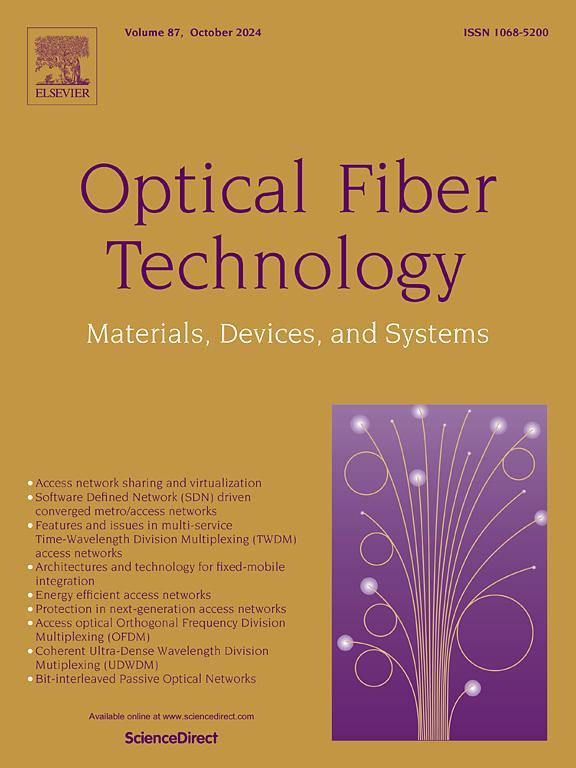Tungsten disulfide nanosheet-sensitized fiber plasmonic biosensors for enhanced sensitivity in hemoglobin detection
IF 2.7
3区 计算机科学
Q2 ENGINEERING, ELECTRICAL & ELECTRONIC
引用次数: 0
Abstract
Assessing hemoglobin (Hb) concentration levels is paramount in medical diagnostics and therapeutics for various hematological disorders. Accurate, rapid, portable, and non-invasive detection of Hb level is highly desired, particularly for severe patients. Herein, a tungsten disulfide (WS2) nanosheet-assisted fiber plasmonic biosensor for sensitivity-enhanced Hb concentration detection is proposed and experimentally demonstrated. The sensor architecture comprises a side-polished multimode fiber (SPMMF) serving as a signal light-guiding waveguide, a gold film supporting surface plasmon resonance (SPR), and an overlayer of WS2 nanosheets amplifying the SPR response. After two deposition cycles of WS2, the sensor achieved a sensitivity of 2450.21 nm/refractive index unit (RIU), representing a 42 % improvement over the unmodified sensor. In Hb detection, a resonance wavelength response of 6.89 nm/(mg/mL) was recorded with the limit of detection (LOD) of 0.13 mg/mL. The Hb sensitivity was 64 % higher than that of the control group without WS2 deposition. In addition to improving sensitivity, the WS2 nanosheet overlayers offer additional benefits such as protection of metal film from oxidation, compatibility with biological systems, and the ability to detect vapor and gas. This work provides a chemical-free, sensitive, and efficient approach for detecting trace biochemical substances.
用于提高血红蛋白检测灵敏度的二硫化钨纳米片增敏纤维等离子体生物传感器
评估血红蛋白(Hb)浓度水平在各种血液疾病的医学诊断和治疗中是至关重要的。准确、快速、便携和无创的Hb水平检测是非常需要的,特别是对重症患者。本文提出了一种二硫化钨(WS2)纳米片辅助纤维等离子体生物传感器,用于灵敏度增强的Hb浓度检测,并进行了实验验证。传感器结构包括一个侧面抛光的多模光纤(SPMMF)作为信号光导波导,一个支持表面等离子体共振(SPR)的金膜,以及一个放大SPR响应的WS2纳米片的覆盖层。经过两个WS2沉积周期后,传感器的灵敏度达到2450.21 nm/折射率单位(RIU),比未修饰的传感器提高了42. %。在Hb检测中,共振波长响应为6.89 nm/(mg/mL),检出限为0.13 mg/mL。与无WS2沉积的对照组相比,Hb敏感性提高64 %。除了提高灵敏度外,WS2纳米片覆盖层还具有其他优点,如保护金属膜免受氧化,与生物系统兼容,以及检测蒸汽和气体的能力。这项工作为痕量生化物质的检测提供了一种无化学成分、灵敏、高效的方法。
本文章由计算机程序翻译,如有差异,请以英文原文为准。
求助全文
约1分钟内获得全文
求助全文
来源期刊

Optical Fiber Technology
工程技术-电信学
CiteScore
4.80
自引率
11.10%
发文量
327
审稿时长
63 days
期刊介绍:
Innovations in optical fiber technology are revolutionizing world communications. Newly developed fiber amplifiers allow for direct transmission of high-speed signals over transcontinental distances without the need for electronic regeneration. Optical fibers find new applications in data processing. The impact of fiber materials, devices, and systems on communications in the coming decades will create an abundance of primary literature and the need for up-to-date reviews.
Optical Fiber Technology: Materials, Devices, and Systems is a new cutting-edge journal designed to fill a need in this rapidly evolving field for speedy publication of regular length papers. Both theoretical and experimental papers on fiber materials, devices, and system performance evaluation and measurements are eligible, with emphasis on practical applications.
 求助内容:
求助内容: 应助结果提醒方式:
应助结果提醒方式:


